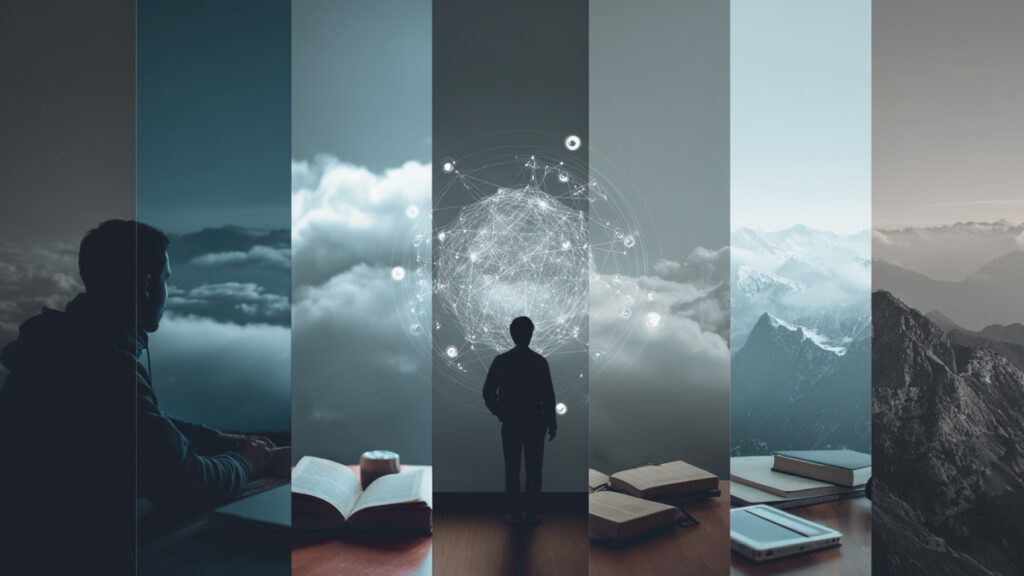Introduction
Christian thought and expression are some of God’s chosen channels of revelation. For millennia God and his creation have talked together, and his creation (people) have documented the result in the form of story, poetry, oratory, and intellectual discourse. The Scriptures (and other communications) have served as the North Star for Christ followers.
For the first time in human history, there is a new voice created by humans interjected into this dialogue: Artificial intelligence (AI). Content development of all kinds is being assisted and generated by AI; with a recent study of 900,000 new websites showing that 74% included some level of AI content.1 In a recent survey across 20 countries and 52 ministries in Africa, 50% of respondents said they were using AI for content creation.2 Countless Christian songs, articles, poems, books, and sermons have this new partner in the mix; invited by humans who are seeking to use AI as they connect with God.
‘Globally, growing AI . . . use [is] a matter of personal convenience and economic gain more than a desire to better communicate truth.’
But the human-machine partnership is often not driven by a search for truth. Instead, AI use tends towards the pragmatic. Globally, growing AI acceptance tends to be tied to economic benefit,3 making its use a matter of personal convenience and economic gain more than a desire to better communicate truth.

Three Ethical Issues in the use of AI for Content Development
As Christian communicators wrestle with integrating AI in their writing, there are at least three ethical issues that are unique to a faith-driven creator.
Inspiration
The first has to do with inspiration. God speaks to people and people use tools. The Evangelical Press Association’s Ethics Statement asks members to ‘. . . agree to honor humans’ unique role, led by the Holy Spirit . . .’4 Discussion about roles will require great wisdom on the part of humanity to set appropriate boundaries. Content creators must ask themselves, ‘What part of this creation process is God calling me to personally invest in and what is God trying to teach me as I make my contribution?’
Honesty
The second has to do with honesty. Communicators build the trust required to communicate God’s truths in a transformational way. If people are to trust the writer as a vehicle of the Holy Spirit, they need to know how the content was developed. A recent UNESCO declaration highlighted the importance of disclosing the use of AI ‘proportionate to the impact of the AI’s role’.5 The question that many creators need to be asking is, ‘How will my use of this tool affect my ability to authentically stand behind what I am communicating?’
Human Responsibility
The third has to do with the power of our communication. Scripture says that we are to love others. If our use of tools leads to plagiarism, errors, ungodly perspectives, and misinterpretations that can come from hallucinations, bias, and incorrect or illegally acquired training data, are we showing love?6
‘. . . between a machine and a human, only the human can be sufficiently self-aware to the point of listening and following the voice of conscience, discerning with prudence, and seeking the good that is possible in every situation.’
The Catholic Church
The Catholic Church articulates this very human responsibility, ‘. . . between a machine and a human, only the human can be sufficiently self-aware to the point of listening and following the voice of conscience, discerning with prudence, and seeking the good that is possible in every situation.’7 Each of us as creators made in the image of the Creator has to ask the question, ‘Am I loving God and my fellow human as I put this content into the world, or is this content more about advancing my selfish desires?’

Implications for Global Mission
As the center of Global Christianity continues to shift,8 the voices speaking into the church are increasingly diverse. Today a Christian can rightly expect to engage with content created from anywhere. Every word is both an opportunity for God to speak to us and simply another human perspective vying for our attention, which is not unlimited.9
Paradoxically, AI is both addressing and causing this dynamic as it unfolds. It is addressing the information overload challenge by providing ways to summarize, translate, and explore large amounts of information very quickly. One example is Meta’s No Language Left Behind, an AI model that can provide translation in 200 languages.10 SIL Global’s AI efforts, along with others, are extending that capability to many of the world’s local languages.11
The integration of AI-generated and assisted content will require Christians to be proficient at contextualizing content to address needs in the appropriate languages as they are identified through local outreach.
At the same time, AI is dramatically increasing the volume of content across all channels and languages. For example, between 2022 and 2023 over 15 billion AI-generated images were created using AI tools.12 This means that those without AI tools to support their creation will soon find it harder to be discovered. In a strange way, it is possible for more information to be available but fewer answers to be found.13 The integration of AI-generated and assisted content will require Christians to be proficient at contextualizing content to address needs in the appropriate languages as they are identified through local outreach.
Conclusion
With millennia of moments for God to speak to his creation and inspire us with truth, we have a rich repository of insight. The Holy Spirit continues to guide every believer to the truth they need to know God and be known by him. The addition of AI to content that supports God’s mission will open new opportunities and require thoughtful use. Humans created AI and must accept responsibility to use the work of our hands in a way that honors our Creator.
Endnotes
- Ryan Law, Xibeijia Guan, and Tim Soulo, 74% of New Webpages Include AI Content: Study of 900k Pages (Ahrefs Blog, May 19, 2025), Accessed August 9, 2025, ahrefs.com/blog/what-percentage-of-new-content-is-ai-generated/.
- Patrick Anyanwu, AI and Christian Mission in Africa (Mission Frontiers, Issue 47-4, July 2025), accessed August 9, 2025, connect.frontierventures.org/mission-frontiers/ai-and-christian-mission-in-africa.
- Matt Carmichael, ed., Conflicting Global Perceptions around AI Present Mixed Signals for Brands (Ipsos, June 6, 2025), Accessed August 9, 2025, ipsos.com/en-us/conflicting-global-perceptions-around-ai-present-mixed-signals-brands.
- Evangelical Press Association, Code of Ethics. Accessed August 9, 2025. evangelicalpress.com/about-us/code-of-ethics/
- United Nations Educational, Scientific and Cultural Organization (UNESCO), Regional Declaration of Press Councils in South East Europe and Türkiye on the Ethical and Transparent Use of Artificial Intelligence in the Media, May 20, 2025, PDF, p. 2, Accessed August 9, 2025,
- Ethics & Religious Liberty Commission (ERLC), Artificial Intelligence: An Evangelical Statement of Principles, April 11, 2019, Accessed August 9, 2025, rlc.com/policy-content/artificial-intelligence-an-evangelical-statement-of-principles/.
- Vatican, Dicastery for the Doctrine of the Faith and Dicastery for Culture and Education, Antiqua et Nova: Note on the Relationship Between Artificial Intelligence and Human Intelligence, January 28, 2025. Accessed August 9, 2025, vatican.va/roman_curia/congregations/cfaith/documents/rc_ddf_doc_20250128_antiqua-et-nova_en.html.
- Todd M. Johnson, Christianity’s Statistical Center of Gravity (Gordon-Conwell Theological Seminary Blog, November 20, 2019), Accessed August 9, 2025, gordonconwell.edu/blog/centerofgravity/.
- Paul Hendriks Vettehen and Gabi Schaap. An Attention Economic Perspective on the Future of the Information Age (Futures 153: 103243, October 2023), Accessed August 9, 2025, sciencedirect.com/science/article/pii/S0016328723001477.
- Meta AI, NLLB-200 High-Quality Machine Translation, (Meta AI Blog), Accessed August 9, 2025, ai.meta.com/blog/nllb-200-high-quality-machine-translation/.
- SIL International. SIL AI & NLP, Accessed August 9, 2025, ai.sil.org/.
- People Are Creating an Average of 34 Million Images Per Day. Statistics for 2024 (Everypixel Journal, 2024), Accessed August 9, 2025, journal.everypixel.com/ai-image-statistics.
- Robert Derow, Stephen Robnett, and Ryne Landers, The Future of Discoverability (Boston Consulting Group Blog, May 13, 2025), Accessed August 9, 2025, bcg.com/x/the-multiplier/the-future-of-discoverability.

